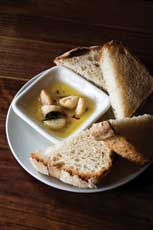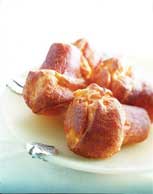

Melissa Matarese
Bread sets the stage for the theatrical meal that follows; hence it is critical to ensure that the opening act is pleasant and memorable. First impressions are everything; and in the dining world, to serve or not to serve house-made bread is the question.
Starving? Pay or wait
Business models for breadbaskets vary tremendously and are more calculated than you may think. Fewer restaurants are bringing bread out immediately as a way to prevent restaurant-goers from filling up too early in the evening. Chefs feel that bringing bread too soon could distract the guests from the full experience of trying a creative appetizer.
If the kitchen is running behind, Chef Gary Rulli of Ristobar in San Francisco will often send olives or peppers to the table, instead of bread. The key is to send out foods that increase, rather than decrease, diners’ appetites. The idea is to “start with an empty stomach and slowly elevate in a smooth manner so when the meal is finished, no one is uncomfortably stuffed.”
Unlike most establishments’ policy of complimentary bread, Bar Bambino and Outerlands, both of San Francisco, take a novel approach. At a small cost of five dollars, Bar Bambino guides its guests to an assorted bread plate that consists of house-made grilled flatbread, brushed with olive oil, rosemary, thyme and oregano with homemade whole wheat crackers. Other nibbles on the menu are cheese platters that feature Firebrand Artisan Breads’ walnut baguette, warmly toasted, and olive oil tastings that are paired with Firebrand’s sourdough baguette. Chef David Mueller at Outerlands doesn’t “give away” his breads but rather sells them at a small fee of two dollars per plate, encouraging people to save their appetites. He specializes in levain bread that is served with a spread of garlic confit, olive oil and fresh herbs.
Bake something your guests will remember
While breadbaskets may be ornate and impressive, accompaniments are typically old favorites such as olive oil and butter. Ristobar is known for its staple, grissini Torinesi, that are part butter, olive oil and semolina. “People just go crazy for them.” Olive oil is also the main ingredient in foccacia bread. Chef Mary Beth at Da Flora in San Francisco bakes a beautiful foccacia that she recommends be brought straight out of the oven to the table. Since the loaf is olive-oil based, it is best served simply by itself.
Ristobar also offers a complex, artisan breadbasket that showcases traditional Italian flavors that are paired with olive oil. Rulli bakes breads in-house to differentiate the dining experience from that of others in the Bay Area. His basket includes an array of exceptional breads such as a golden raisin and walnut baguette, which is scissor-sliced to resemble individual rolls, and thinly sliced spelt flour bread with walnuts and sunflower seeds. Grains in the nine-grain whole wheat are soaked overnight in water, imparting a rustic taste. Other simple, yet satiating basics, include Sicilian pistachio, green olive and calamata olive breads. Rulli also embraces his preparations with zest and texture. The panettone Genovese is a heavy, rich dough, coated with raisins, candied orange peel, citron and pine nut; it is then sliced paper-thin and topped with mascarpone cheese. The final inclusion is a recent creation, Southern Italian style bread with pig lard, mortadella, pistachios, diced salami, and fennel seed.
Olive oil may be the natural pairing for Italian slanting venues, but whipped butter rules elsewhere. The Zodiac Room, the restaurant within upscale department store Neiman Marcus, is well-known for its irresistible popovers served warm with whipped, strawberry butter. Created in the 1950s, the popover was served at chic restaurants and events, but Neiman Marcus turned it into their signature dish. The popover was originally served with separate strawberry preserves and butter, but the need for operational efficiency created the whipped combination spread they serve today.
The breadbasket of Opal Restaurant in Santa Barbara is comprised of homemade parmesan focaccia and a multigrain baguette with a hint of molasses. Since breads are baked on-site, the basket can be varied to include harvest, nut and potato garlic breads. These breads are served with room temperature, house whipped butter.
Nurturing bread the natural, artisanal way
Matt Kreutz at Firebrand Artisan Bread in Oakland crafts naturally leavened, handmade and firewood-baked breads. When working with delicate ingredients, Kreutz cautions to “respect the ingredients, know them, care for them and give them what they need.” Strict attention must be paid to the state of the flour, as these all-natural ingredients, including wild yeast, must be fed repeatedly over the course of a few days. Its journey involves multiple risings, shaping and storage in temperature and humidity controlled conditions; this environment is flavor inducing.
Naturally leavened bread lengthens the baking process, but by avoiding stabilizers and dough enhancers, the complex flavors of the dough prevail. With commercial packets, mixing and rising can take just a few hours but yield less intricate aromas. The less yeast used and the longer the fermentation, the more flavorful and complex the final product.
When it comes to Firebrand’s bread offerings, they steer clear of rolls. With a wood fire oven, the smaller the bread, the more difficult it is to produce consistent ratios of crumb to crust. Though retail purchasers can tolerate odd shapes or dark patches on smaller breads, wholesale buyers expect loaves to look identical. Because of this, Firebrand bakes loaves between one and five pounds, preserving freshness by not pre-slicing the bread.
The craft of bread making is undoubtedly scientific and mathematical in nature. However, as environmental factors change, the baker must rely on intuition. Coping with uncontrollable factors poses a great challenge to bread preparation. Chef Cheryl Burr of Pinkie’s Bakery compensates for San Francisco’s foggy, and sometimes humid, conditions by adding less water to the bread mixture, which she calls her “baby.” Cheryl’s baby is a mixture of water and flour that comprises 50 percent of each levain loaf; the natural yeast in the air creates a fermentation process, although yeast is added on occasion to achieve airy bubbles in the dough. To attain the freshest flavor, Chef Burr gives lots of “human love and attention” to her babies. Pinkie’s Bakery’s levain bread varieties include Meyer lemon black cracked pepper and toasted walnut. She only sells to dinner service restaurants to ensure the freshest possible presentation of her artisan crafts.
Sadie Rose Baking Company in San Diego also emphasizes a natural process without the use of preservatives. Breads rise slowly and are baked in a stone hearth to create caramel color and crunchy crust. The bakery can produce breads “par-baked,” meaning that the bread can be cooked and warmed on site. Many of their clients, including The Cellar in San Clemente, request that bread be shipped par-baked so that they can serve warm, fresh bread without needing to have a bread baker in-house.
The seemingly small decision on bread offerings can have a profound impact on a diner’s experience, with a memorable bread course acting as a harbinger for the meal to follow. To bake or not to bake? That is the question only you can answer.
Melissa Matarese judges every restaurant by its bread. She is known to be the first to get her fingers in the breadbasket and fervently sniff her baguette. She holds degrees from Johns Hopkins University and the University of Cambridge where she pursued the art of dining in her spare time. Based out of New York City, she writes about the New York Dining Scene on her Blog: L’Epicurien of View from the Front Row. melissa.matarese@gmail.com


